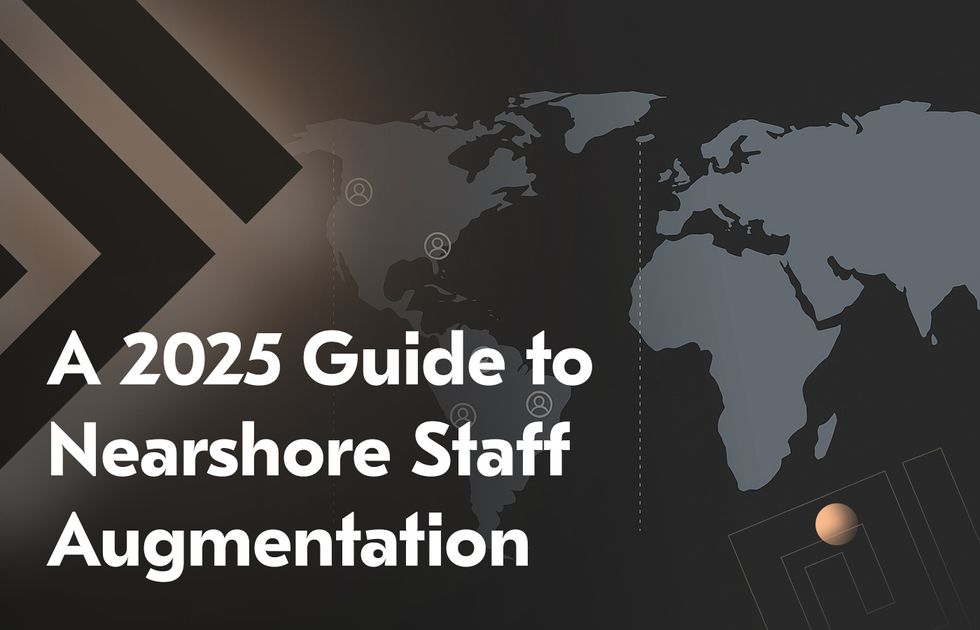
Key Takeaways
- Nearshore staffing solutions blend in‑house control with outsourced specialist expertise, enabling seamless integration into existing teams without full project hand-offs.
- Businesses gain rapid access to niche skills, cut labor costs by 30-45% in LATAM or CEE, and accelerate time‑to‑market through overlapping time zones.
- Driven by demand for flexible, project‑based tech talent, the global IT staff augmentation market will surge from $299.3 billion in 2024 to $857.2 billion by 2031.
- Inexpensive nearshore rates land somewhere between onshore and offshore, helping you keep a pretty predictable budget while avoiding the expensive price tag of your in-house hires.
Traditional ways of working together are quickly disappearing due to the rapid pace at which technology is changing and so too are the demands of customers. Nearshore staff augmentation provides a flexible way to boost your in‑house skill sets without adding overhead of traditional hiring.
And no, it never occurred to you that experienced developers, test engineers, UX or DevOps from geographically close locations (same time zone, work culture) who could share your business hours and not have any interference with holiday times would be a great idea.
Whether you are launching a new feature, scaling after the funding round, or finding yourselves with an unexpected backlog, nearshore IT staffing breathes renewed energy to your projects and lets you keep up with change.
Nearly 80% of companies in North America are now exploring nearshore partnerships for key initiatives, spanning industries from fintech and healthcare to e-commerce and logistics.
With over 20 years of augmenting clients’ teams to build custom software cost-efficiently, Acropolium will explore what nearshoring actually is. Find out who and how can benefit from this cooperation model and what it takes to make it work for your business.
What Is Nearshore Staff Augmentation?
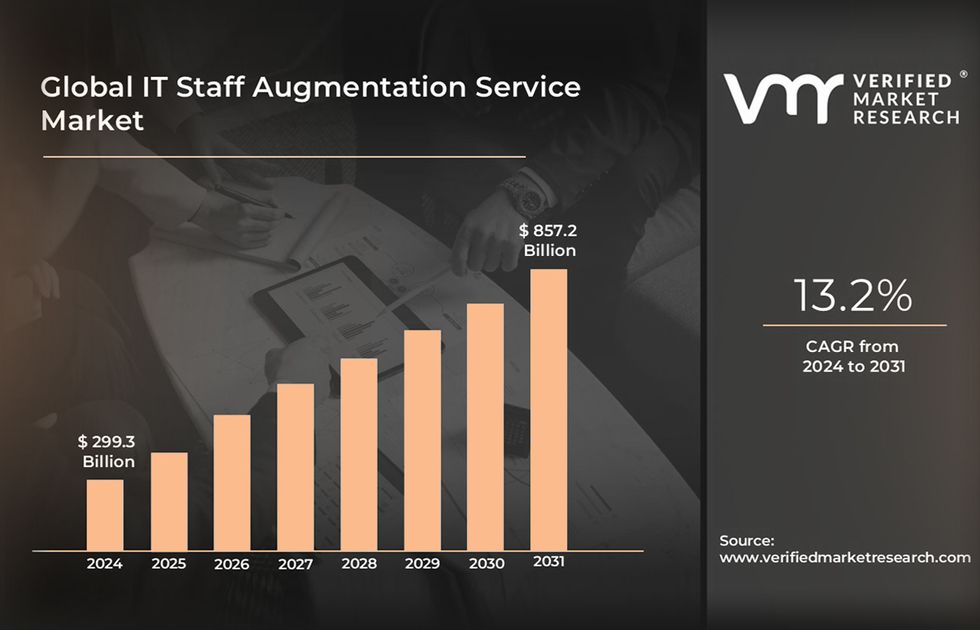
Nearshore staff augmentation is a balance between internal resources and external professionals from countries that are close by (for instance, across the border). Nearshoring is different from outsourcing, where an entire project gets outsourced or in‑house hiring as it injects the external specialists into your established teams.
This is very much a model of how you can generate a level of flexibility to team building, and therefore speed in deployment, bringing on the specific skill you need and for only as long as you will need it. Your business retains full managerial authority, slips augmented staff naturally into your work processes, and scales as the project goes through ups and downs.
The market for IT staff augmentation is $299.3B in 2024, and it will grow to $857.2B by 2031, at an annual rate of 13.2%. This growth mirrors the increased necessity for flexible tech talent on a project basis as a natural response to skill shortages in an era of rapid digital transformation and the need for long-lasting teams sans traditional full-time commitments.
Companies increasingly turn to nearshore dev team augmentation and remote experts to accelerate delivery, control costs, and stay ahead of the tech curve.
Benefits of Nearshore Staff Augmentation
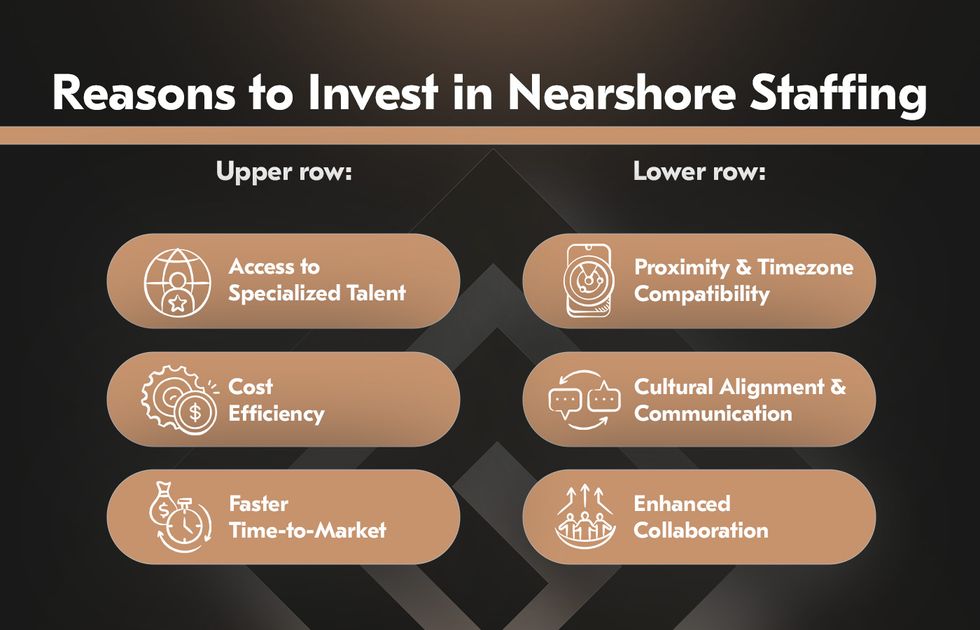
Rather than offering specifics, how about we take a look at the ways in which nearshore staff augmentation services balance strategic agility with operational excellence. Organizations can accelerate development and create a seamless extension of their teams by bringing specialized talent to them.
Now let’s see what you could achieve if you combined that benefit with the potential for borderless talent acquisition and local, hands-on work partnership.
Access to Specialized Talent
From React apps to data science and cybersecurity, nearshore regions can often leverage their training capacity because of their successful skill pools in a desirable technology lacking in your domestic market. Instead of settling for generalists or waiting months for a rare hire, you tap into a curated network of professionals who have proven experience in your technology stack.
This targeted approach lets you assemble the precise expertise required for each project phase, from prototyping to enterprise rollouts.
Cost Efficiency
Labor rates in neighboring countries typically fall below those in onshore hubs, yet quality standards remain high. With nearshore staff augmentation, you gain full-time contributions from skilled engineers without the overhead of benefits, office space, or long-term contracts.
In LATAM, where labor costs still are markedly lower than onshore markets, offshoring reduces prices by 30-45% in many cases. These savings will vary with role complexity, necessary knowledge and seniority, but this still a solid middle ground for cost/performance when scaling up tech teams.
By reallocating this money to more product development, further UX enhancements or deeper market research you can continue to stretch your budget, all without compromising on output.
Faster Time-to-Market
Nearshore staff augmentation vendors maintain overlapping business hours, so that new hires can join sprint planning sessions and stand‑ups immediately. There’s no need to adjust for extreme timezone differences or delayed hand-offs.
As a result, your team moves from concept to release with fewer interruptions, turning market opportunities into live features in days instead of months.
Proximity and Time Zone Compatibility
Working within one or two hours of your own timezone simplifies scheduling and ensures real‑time communication. Developers and nearshore staff augmentation experts can join daily stand‑ups, troubleshoot issues on the go, and participate in urgent bug‑fix calls, just as if they were sitting next door.
Such synchronicity eliminates the lag inherent in far‑flung outsourcing and keeps momentum high throughout each development cycle.
Cultural Alignment and Communication
Common lexical and business practices will create a harmony earlier than it begins. Teams nearshore have the advantage of being fluent in idioms and social customs, as well as working schedules or holidays which may avoid unexpected delays that can compromise a project.
But do it before this so cultural closeness leads to fast trust in the beginning. This will speed up feedback loops and decision-making down the line to better your strategy meetings, code review and design workshops.
Enhanced Collaboration
Nearshore staff augmentation professionals with a similar work ethic and collaborative tools complement your current processes. It can be anything from Jira for task tracking and GitHub for version control to Slack for internal comms.
In-house and nearshore employees are both measured as a team with the use of reflection variables. Teams will work together to solve problems on dashboards, which gives everyone visibility into how far along they are. That consistency provides the guarantee that deliverables are of an equal standard, irrespective of location.
Onshore vs. Offshore vs. Nearshore Staff Augmentation
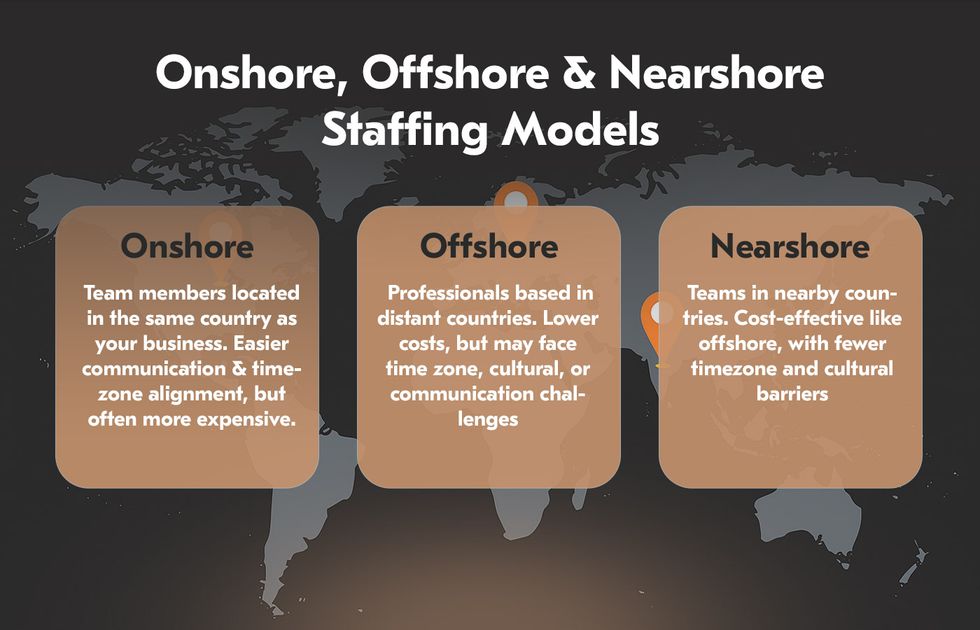
Choosing the right staffing model depends on more than just cost. The successful business relationships find the right blend of hand holding, control, access to talent and integration with internal processes. Below, you can see how offshore staff augmentation compared to nearshore and onshore varies along fundamental operational and strategic dimensions.
Onshore: Local Talent, Maximum Oversight
Onshore staff sourcing includes hiring employees from your own country. Time zone, cultural fit and legal framework in which you cooperate are the most frictional aspects of working with this model. Immediate communication, and the ability to oversee projects as everyone is working closely together.
Users are now able to enjoy everything they want without stepping out of the house, at a price. Labor from onshore resources can be very expensive, particularly where wage levels are benchmarked to local salaries in the west, most notably, North America and Western Europe.
Additionally, attracting talent from the local talent pool may also be challenging, especially for key tech roles such as DevOps or AI/ML. This can result in time-consuming hiring processes or even skill level compromises.
Nearshore: Balanced Performance and Cost
Nearshore staff augmentation is a mix of the other two approaches (onshore and offshore) which results from balancing cost-efficiency with immediate communication. Working with adjacent countries usually situated within 1-3 time zones, businesses get international talent without compromising voice communication quality and team unity.
Cultural and linguistic proximity is one of the main benefits that sets nearshoring apart. This will enable better communication, enabling a little less friction in onboarding, and making the day-to-day team collaboration stronger. Most nearshore teams speak English and are taught to abide by Western work ethics and project management.
Although the prices are lower than onshore hiring, with nearshoring you have more transparency and control compared to hiring offshore. Quick scalability and operational agility For companies that need flexibility as fast as they can, nearshore IT staffing is the most strategic choice to do so.
Offshore: Scale at the Lowest Cost
For US or Europe-based companies, offshoring means hiring teams from far off nations, and many times working across different time zones, in South or Southeast Asia. Like nearshore staffing solutions, this model is used to save costs as wages are generally cheaper than in onshore markets.
It really makes sense to do offshoring for your long-term development or maintenance projects simply because real-time collaboration is not required here. Even so, there are a few drawbacks. Time zone differences can lead to issues with communication, while language problems and cultural crossover might have an effect on a project velocity.
In addition, you will typically have more formal governance structures to manage your offshore team, such as using offshore vendors or BPOs, which means you may have less direct oversight and need stronger documentation and asynchronous workflow.
Here’s a breakdown of the main differences between the three models:
| Factor | Onshore | Offshore | Nearshore |
|---|---|---|---|
| Collaboration Efficiency | High overlap, minimal barriers | Limited overlap, significant time lag | Excellent overlap, cultural affinity |
| Project control | Direct management | Often vendor‑led, less direct control | Direct management with remote oversight |
| Cost | Highest labor rates | Maximum cost reduction | Moderate savings vs. onshore |
| Communication Barriers | Low | High (language, cultural differences) | Low to moderate |
| Talent Pool Depth | Limited by local market | Vast global pool | Broader, specialized regional expertise |
When to Choose Nearshore Staff Augmentation
Nearshore software staff augmentation makes the most sense when speed, focus, and cost control are critical, especially for teams that need to scale quickly without sacrificing technical depth or collaboration quality. It is particularly valuable when internal hiring pipelines are too slow, or when outsourcing adds unnecessary complexity and detachment.
Startups often rely on nearshoring to build MVPs under pressure, meet investor deadlines, or rapidly develop features without committing to long-term hires. Mid-sized companies use it to bridge skill gaps when launching new digital services. Even established enterprises turn to nearshore teams to handle surges in workload without overburdening in-house developers.
Central and Eastern Europe (CEE), with countries like Ukraine and the Czech Republic leading the pack, have become a prime hub for nearshore software development because of its positive combination of:
- Strategic location and proximity. Both CEE’s and LATAM’s proximity to western Europe and America lets people travel easily and work together in real time. Czechia’s position, for example, means that teams can be at work during hours when Germany, Austria or England are also on duty.
- Deep talent pool. In countries like Ukraine and the Czech Republic there are many software engineers with advanced English who have been trained in universally used technologies. They also have experience of cross-border projects. Unlike other regions, CEE Countries have not been burdened with years of piracy issues and inflation in their currency.
- Cost efficiency. CEE-based labor costs are still 70% lower than in Western Europe and the quality of delivery is very high. That places the region in league with other cost-effective locales, but in a more favorable timezone and more like-minded culture settings.
- Infrastructure and EU integration. As part of the European Union, CEE countries made a huge rush to fix their logistics and IT infrastructure. The Czech Republic, Poland and Hungary now have expanded motorway systems and efficient cross-border connections. Also, they have data and labor regulatory alignment with EU law.
Best Practices for Nearshore Staff Augmentation
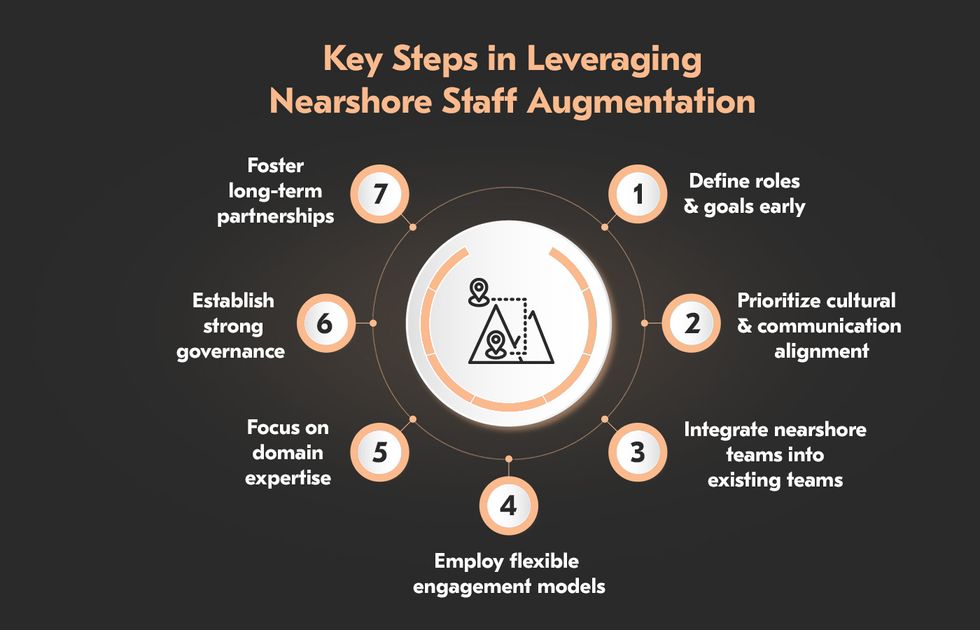
To tap into the cost-effective benefits of nearshore IT staff augmentation, you need to plan carefully, communicate clearly and work towards alignment between your core team and augmented resources. Below are leading practices that guarantee your nearshore interaction will deliver an impact.
Define Clear Roles and Expectations Early
If you are hiring a full-time dedicated nearshore team, or just outsourcing certain areas to help with the project, defining all the roles and responsibilities is crucial. Specify robust deliverables, communication cadences, and KPIs from the very beginning. That’s the foundation that will help to avoid overlaps or gaps and keep projects aligned.
Prioritize Cultural and Communication Alignment
Even within geographical proximity, culture-specific nuances and work styles can be further framed. Spend resources on onboard personnel from the nearshore staff augmentation agency for your company culture and workflows.
Schedule video meetings frequently and pick software that allows for communication to be transparent and in real-time. Speaking a common language and sharing compatible time zones can also reduce communication issues and create efficiencies by making decisions more quickly.
Integrate Nearshore Teams as an Extension of In-House Staff
Treat nearshore staff augmentation experts as if they were part of your internal development ecosystem and family, not merely an outsourced contractor. Make them a part of sprint planning, dissent code reviews and product discussions. You want the whole team to be responsible and cohesive, rather than suppressed around it instead of doing good work.
Embrace Flexible Engagement Models to Control Costs
One of the factors where nearshore staff augmentation holds an edge over in-house is flexibility in terms of scaling teams up or down. Choose an engagement model like Acropolium’s custom development as a service that will meet your cost and timelines.
This keeps you away from the overheads of full-time hiring and retains a privileged on-demand talent pool not available locally.
Focus on Skills and Domain Expertise
Find out what it takes to build a platform like yours, identify the tech skills and industry knowledge required for your future project. Ukraine and the Czech Republic are homes to many software engineers with experience in high-tech and fintech requirements, all of which are supported by nearshore staff augmentation providers.
Carefully vetting your candidates and ensuring you can match skillsets to task demands helps accelerate development and produce a higher-quality end product.
Establish Strong Governance and Feedback Loops
By using regular check-ins, progress tracking and performance reviews this transparency makes the team that adaptable. Build clear escalation paths and actionable feedback loops for the quick resolution of challenges. A proactive governance ensures at the right time the right actions are taken and there is a continuous improvement.
Foster Long-Term Partnerships
When you develop strong, long-term relationships with your nearshore staff augmentation agency, it is much more than just a way of lowering costs in the short term. Having a partner that knows your business goals will provide strategic recommendations to aid in the product innovation and efficiency department.
When organizations commit to continuously working together, bringing your workers up to speed on later ventures gets a lot quicker.
Why Choose Acropolium for Nearshore Staff Augmentation?
Acropolium brings almost two decades of bespoke software development and a deep understanding of nearshore collaboration. We leverage proven recruitment pipelines to deliver engineers who match your tech and cultural requirements.
Our flexible engagement strategies allow you to scale teams promptly, while ISO‑certified processes ensure quality and security. With dedicated account management, transparent reporting, and ongoing skills development, Acropolium becomes an extension of your organization, helping you innovate and remain competitive while reducing development costs.
And here’s one of our clients’ success stories as proof.
Legacy Platform Modernization for an E-commerce Partner
A UK‑based retail leader faced an aging e‑commerce platform that struggled with slow page loads, poor mobile performance, limited integration options, and security gaps. They needed a full‑scale migration to a modern, scalable online store that could handle growing traffic, enable AI‑driven personalization, and connect seamlessly with third‑party tools.
Solution
- We conducted an in‑depth audit to identify bottlenecks and crafted a headless, microservices‑driven architecture for seamless integrations and rapid feature updates.
- A mobile‑first redesign and an AI‑powered search and recommendation engine improved user engagement.
- Secure APIs and automated data migration ensured reliability and uninterrupted operations.
- Agile delivery and continuous stakeholder reviews kept the project on track.
Results
- Infrastructure and maintenance expenses fell by 40%.
- Revenue increased by 22% within six months.
- Page‑load times improved by 65%, reducing bounce rates by 28%.
- Mobile conversion rates climbed 35%.
Final Thoughts
Nearshore staff augmentation strikes a practical balance between speed, quality, and control. When done right, it offers not just short-term relief but long-term value: easier collaboration, better integration with in-house teams, and faster time to market.
With Acropolium, you can access specialized talent on demand through a flexible, subscription-based model that supports everything from MVP launches to enterprise-grade system builds. From supply chain and hospitality to fintech and education, we have the talent to cover diverse needs.
Contact us to find out how this model can streamline your business!









![8 Risks of Software Development Outsourcing [Their Solutions]](/img/articles/software-development-outsourcing-risks/img01.jpg)
![How to Outsource App Development [2025 Guide]](/img/articles/how-to-outsource-app-development-benefits-tips-and-cost/img01.jpg)


![Nearshore Software Development: [2025 Guide]](/img/articles/a-guide-to-nearshore-software-development-find-the-best-outsourcing-model/img01.jpg)
